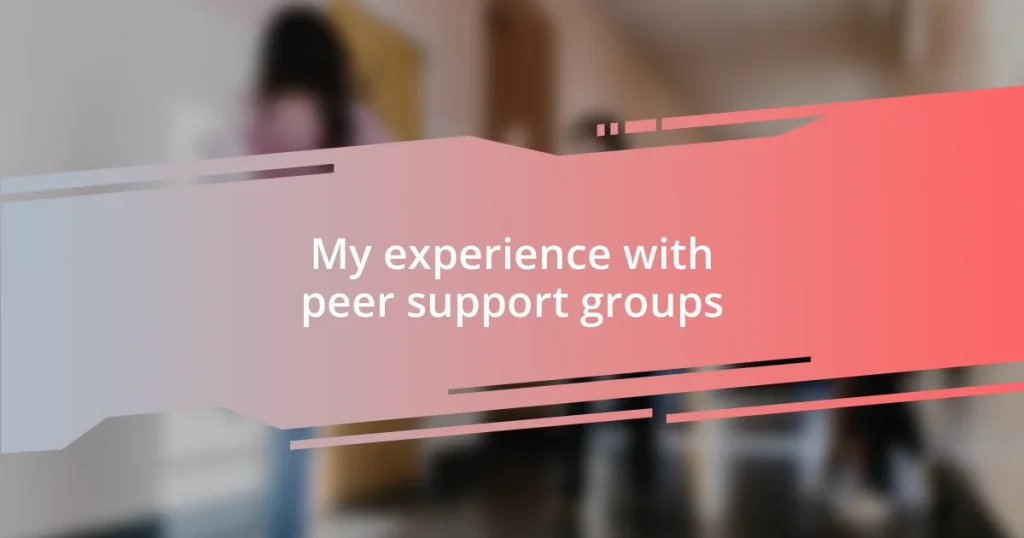Key takeaways:
- Peer support groups foster connections through sharing experiences, creating a sense of community and mutual growth among members.
- Common challenges in these groups include dominating voices, varying levels of vulnerability, miscommunication, emotional triggers, and differing commitment levels.
- Effective strategies to enhance group dynamics include setting clear participation guidelines, encouraging vulnerability, and actively checking in with members to promote a sense of belonging.

Understanding peer support groups
Peer support groups are spaces where individuals with shared experiences come together to connect and uplift each other. I remember stepping into my first session, feeling a mix of anxiety and hope. It was comforting to see others who understood the struggles I faced; it felt like finally finding a home for my feelings. Isn’t it fascinating how just being in the same room with people who truly “get” you can shift your perspective?
The essence of peer support lies in the mutual sharing of experiences and insights, creating a supportive network where everyone can learn from one another. I once listened to a member share their journey in such a heartfelt way that it resonated deeply with my own circumstances. It made me think: how often do we feel alone in our struggles, when in reality, there are countless others navigating similar paths right alongside us?
With each meeting, I found myself not just receiving support but also giving it, which created a powerful sense of community. Have you ever noticed how helping others can often aid your own healing? This reciprocal dynamic in peer support groups fosters resilience and encourages growth, reminding us that we are never truly alone in our journeys.

Key challenges faced in groups
While peer support groups can feel like a haven, they also come with unique challenges that can impact group dynamics. I recall one session where a member dominated the conversation, drowning out others. It was frustrating because I could see the hesitation in newer members who had things to share, yet felt overlooked. It highlighted for me how important it is to create space for everyone to voice their thoughts, fostering a true sense of inclusivity.
Here are some common challenges that can arise in peer support groups:
- Dominating voices: Sometimes, more vocal members can unintentionally overshadow quieter individuals.
- Varying levels of vulnerability: Not everyone is at the same stage in their journey, leading to discomfort among members who are either too open or too reserved.
- Miscommunication: Without careful discussion, misunderstandings can arise, creating tension within the group.
- Emotional triggers: Sharing personal stories can bring up painful memories, which may lead to emotional distress for some members.
- Commitment levels: Different expectations about participation can cause frustration, especially if some members aren’t as engaged.
These challenges require awareness and compassion, reminding me that peer support is a delicate dance where everyone must feel valued.

Strategies to maximize group effectiveness
One of the most impactful strategies I found in peer support was setting clear guidelines for participation. It struck me during a session when the facilitator gently reminded us to ‘share the air.’ This simple phrase encouraged everyone to express thoughts without fear of dominating the conversation. It made me wonder: how often do we forget the power of listening? Creating a culture of shared voices made every session more enriching.
Another approach that proved invaluable was encouraging vulnerability in a controlled setting. I vividly remember a newcomer opening up about their struggles while the rest of us listened intently, acknowledging the courage it takes to share. It’s fascinating how a safe environment can prompt even the most reserved individuals to open up. How do we foster that level of trust? I believe it starts with the group establishing mutual respect and actively validating each member’s contributions, which leads to deeper connections over time.
Lastly, I learned that actively checking in with members can significantly enhance the group’s effectiveness. After noticing a member who seemed quieter than usual, I decided to reach out after the meeting. Their gratitude for the follow-up made me realize the value of personal touch. When we take the time to inquire about how everyone is doing, it fosters a sense of belonging and care. Have you ever considered how a simple ‘How are you feeling today?’ can change the atmosphere in the room? It’s these little gestures that transform gatherings into meaningful connections, ultimately making the group stronger.















